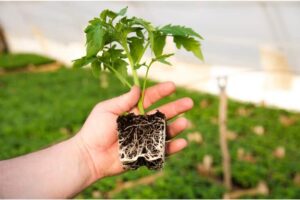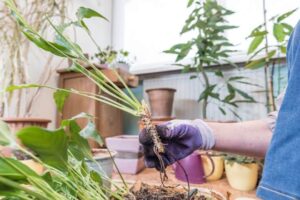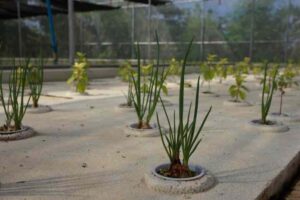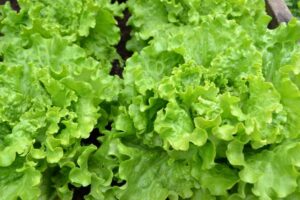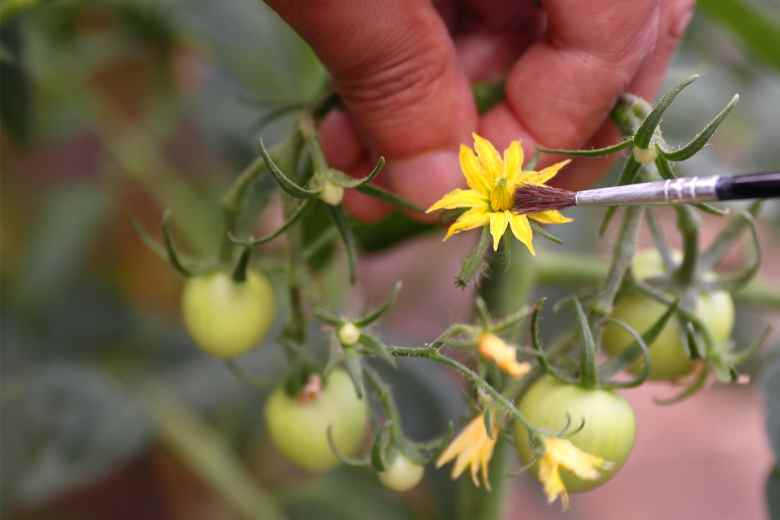
Tomato flowers are a beautiful sight to behold, but their purpose extends far beyond aesthetics. They’re an integral part of the fruit-bearing process, with their pollination being a critical step toward a successful tomato harvest.
Yet, how can you tell if a tomato flower is pollinated? This question may perplex many garden enthusiasts but worry no more. We’re here to delve into this intriguing topic and provide you with comprehensive insights.
Six Indicators of Tomato Flower Pollination
Indicator 1: Flower Droop
A few days post-pollination, the tomato flower will start drooping. This downward tilt is a positive sign, indicating the redirection of energy towards fruit formation.
Indicator 2: Petal Color Change
The vibrant yellow petals of the tomato flower will start turning a dull brown post-pollination. This change of color is an indication of successful pollination and a signal that the petals have served their purpose.
Indicator 3: Petal Drop
Subsequent to the color change, the petals start to drop off, leaving behind the base of the flower. While this may seem alarming, it’s actually a normal progression in the plant’s pollination process.
Indicator 4: Green Bulge Formation
Post petal drop, you’ll notice a green bulge at the base of the flower, which is the ovary. This is a clear indication that the pollination process was successful, and this bulge will eventually develop into a tomato.
Indicator 5: Development of the Tomato
Over the following weeks, the green bulge transforms into a fully developed tomato, indicating that pollination was not only successful, but the fruit set was successful as well.
Indicator 6: Plant Health and Vigor
Healthy and vigorous plants are more likely to have successful pollination. Indicators of plant health include robust green foliage, strong stems, and a steady production of new flowers.
DO TOMATO FLOWERS NEED TO BE POLLINATED?
1. The Significance of Pollination
Pollination is the transfer of pollen from the male part (anther) of a flower to the female part (stigma) of either the same flower or another flower. This process leads to fertilization, which in turn triggers the production of fruit and the seeds within the fruit. For tomato plants, each flower has the potential to become a tomato, but only if pollination occurs.
2. The Self-Pollinating Nature of Tomato Plants
Tomato plants are unique as they are self-pollinating. Each tomato flower contains both male and female reproductive organs. The male organ, called the stamen, contains pollen, while the female organ, called the pistil, has a stigma where the pollen needs to land for fertilization to occur. In an ideal scenario, vibrations from wind or visiting insects shake the pollen loose from the stamen, causing it to fall onto the pistil.
3. Challenges to Natural Pollination
While tomato plants are equipped to pollinate themselves, certain conditions can interfere with this process. High humidity can cause pollen to stick together, preventing it from falling onto the pistil, while low humidity can dry the pollen out, making it less effective. Additionally, extremely high or low temperatures can render the pollen sterile, inhibiting pollination.
4. Assisting the Pollination Process
Given these challenges, gardeners can assist the pollination process in several ways:
- Plant Shaking: Gently shaking the plant or tapping the back of the flower can mimic the natural vibrations that would dislodge pollen.
- Manual Pollination: A small paintbrush can be used to collect pollen from the stamen and transfer it to the pistil.
- Creating a Bee-friendly Environment: Planting flowers that attract bees or using a bee house can encourage more bees to visit your garden, increasing the chances of pollination.
Techniques to Encourage Pollination
Sometimes tomato plants need a little assistance to achieve successful pollination. Here are a few techniques that can boost your pollination success rate:
Technique 1: Plant Shaking
Tomato plants can self-pollinate, but sometimes they need help to move the pollen from the stamen to the pistil. This can be achieved by gently shaking the plants or tapping the back of the flowers.
Technique 2: Manual Pollination
If plant shaking doesn’t do the trick, you can opt for manual pollination. Using a small paintbrush, you can transfer pollen from the stamen to the pistil, simulating what naturally occurs in the wild.
Technique 3: Bee Attraction
Bees play a pivotal role in pollination. Planting bee-friendly flowers nearby or setting up a bee house can encourage their presence, resulting in improved pollination.
Technique 4: Optimal Environment
Tomato plants thrive in certain conditions. Providing optimal sunlight, ensuring the right temperature range (60-85°F), and maintaining appropriate humidity can significantly enhance the pollination process.
Technique 5: Healthy Plant Maintenance
Keeping your plants healthy boosts their pollination success rate. Regular watering, adequate spacing for airflow, and pest control contribute to plant health, thereby encouraging pollination.

Troubleshooting Non-Pollinated Tomato Flowers: What to Do When Your Tomato Flowers Aren’t Pollinating
Despite your best efforts, there might be instances where you find your tomato flowers are not getting pollinated. This is a common challenge faced by many garden enthusiasts. However, understanding the potential causes can provide the insights necessary to troubleshoot the issue. So, let’s delve into some of the reasons why your tomato flowers may not be pollinating and how you can rectify this issue.
Understanding the Causes
1. Inadequate Temperatures
Tomato plants thrive in a specific temperature range for successful pollination, usually between 60-85°F. If the temperatures are consistently outside of this range, either too hot or too cold, it can result in pollen becoming unviable.
2. Humidity Extremes
High humidity can cause the pollen grains to stick together and become too heavy to fall from the stamen to the pistil. On the other hand, low humidity can dry the pollen out, making it less viable for successful pollination.
3. Insufficient Light
Tomatoes need ample sunlight to grow and pollinate properly. If your plants are situated in a heavily shaded area, it might impact their ability to pollinate.
4. Lack of Pollinators
While tomatoes are self-pollinating, they can benefit from pollinators like bees. If there are few or no bees visiting your garden, it might be affecting your tomato plants’ pollination.
5. Nutrient Deficiencies
Tomatoes need a balanced mix of nutrients for their overall growth and pollination. Nutrient deficiencies can affect plant health, leading to unsuccessful pollination.
Remedial Measures
Understanding the root cause of non-pollination allows you to take corrective measures. Here are some potential solutions:
1. Regulate Temperature and Humidity
If temperatures are not within the optimal range, consider moving the plants to a location where they can get the right temperatures. For humidity issues, consider using a greenhouse or humidity trays to control the environment better.
2. Increase Sun Exposure
If lack of sunlight seems to be the issue, consider relocating your tomato plants to a sunnier location or use artificial grow lights to supplement natural light.
3. Attract More Pollinators
Planting pollinator-friendly flowers or setting up a bee house can attract more bees to your garden, aiding in tomato flower pollination.
4. Provide Nutrient-Rich Soil
Ensure your tomatoes are receiving the right nutrients. A balanced tomato-specific fertilizer can provide the essential nutrients required for healthy growth and successful pollination.
5. Manual Pollination
Sometimes, despite all your efforts, nature needs a helping hand. Manually pollinating your tomato flowers using a small brush or even your finger can help ensure pollen transfer. Gently tap the flower’s back or shake the tomato cage to mimic the natural vibrations caused by wind or bees.
Non-pollinated tomato flowers can be a cause of concern for gardeners, but by understanding potential causes and taking appropriate corrective measures, you can help your tomato plants thrive. However, successful gardening often requires a blend of patience, observation, and timely intervention.
Troubleshooting non-pollinated tomato flowers might seem challenging initially, but it’s all part of the rewarding journey of growing your own produce. Happy gardening!
FAQs About the How To Tell If Tomato Flower Is Pollinated
How long after pollination does the tomato grow?
Answer: After successful pollination, it usually takes around 20-30 days for a green tomato to form and another 20-30 days for it to ripen, depending on the variety of the plant and environmental conditions.
How can I ensure my indoor tomato plants are pollinated?
Answer: For indoor plants, manual pollination may be necessary. This can be done by lightly shaking the plant or using a small paintbrush or an electric toothbrush to mimic the action of wind or bees.
Can I still get tomatoes if the flowers fall off?
Answer: If the flower falls off soon after blooming, it’s likely that pollination didn’t occur. However, a tomato plant will produce many flowers throughout its life, so it will have other opportunities for successful pollination.
Can I use any type of tomato flower for pollination?
Answer: Yes, as long as the flower has opened and the stamen and pistil are mature, it can be pollinated. Tomato flowers typically open about a week after they appear.
Is there any way to speed up the process of a pollinated tomato flower turning into a tomato?
Answer: Yes, providing your tomatoes with plenty of sunlight and water can help speed up the process of a pollinated tomato flower turning into a tomato.
Conclusion
After reading this article you should have a better understanding of how to tell if your tomato flower is pollinated.
In essence, understanding and aiding the pollination process of tomato flowers is a critical factor for a fruitful harvest. This involves recognizing pollination signs, using techniques to encourage pollination, troubleshooting non-pollinated flowers, and comprehending their self-pollinating nature. Armed with this knowledge, you’re well-equipped to ensure a thriving tomato garden, yielding a bountiful and rewarding harvest. Keep an eye out for those telltale signs of pollination and remember: every successful pollination is a step closer to a juicy, homegrown tomato!

